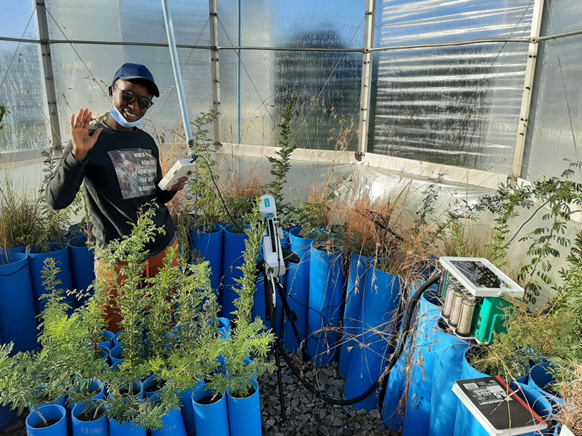In this ‘Behind the Paper’ blog post, author Dr. Edith Singini, a lecturer at Rhodes University, delves into her new paper ‘Savanna tree species show contrasting acclimation responses to elevated atmospheric CO2 concentration and drought’. Edith shares her team’s research into why some trees are winning the encroachment race and discusses the logistical demands of a year-long experiment.
1. About the Paper
Across Africa’s grass-dominated savannas, trees are slowly but steadily taking over. This expansion of woody plants, known as encroachment, is transforming ecosystems, threatening biodiversity, and changing how savannas function. My recent paper in Functional Ecology, “Savanna tree species show contrasting acclimation responses to elevated atmospheric CO2 concentration and drought,” set out to understand why only some trees are winning this race.
We often hear that rising CO2 helps all trees grow faster, but our results show a much more selective story. Using an Open-Top Chamber system at the Rhodes University Elevated CO2 Facility, we grew five southern African tree species under current (400 ppm) and future (550 ppm) CO2 levels, combined with wet and dry soil conditions.
Three of the species, Vachellia karroo, V. tortilis, and V. sieberiana, upregulated their photosynthetic machinery in response to high CO2, especially when water was available. These same species are well-known encroachers across African savannas. In contrast, V. robusta and Senegalia burkei showed weak or even negative responses.
The key message? Rising CO2 will not benefit all trees equally. Some species possess the physiological flexibility to thrive under higher CO2 and variable rainfall, while others remain constrained. Understanding these differences helps explain why certain trees dominate as climates change, and why models predicting woody expansion must move beyond broad “tree” categories to capture species-level behaviour.
2. About the Research
Our experiment ran for nearly a year, and it was as logistically demanding as it was exciting. Maintaining constant CO2 levels in open-air chambers under South African weather required daily monitoring, calibration, and some creative troubleshooting! Each week, we measured photosynthesis using the LI-6800 gas-exchange system, generating ACi curves (curves showing increasing photosynthesis-A as a function of intercellular CO2 -Ci) to quantify two key parameters: the carboxylation rate (Vcmax) and the electron transport rate (Jmax). These traits reveal how efficiently plants use CO2 to fix carbon.
Rainfall was both a challenge and a gift. Unexpected showers blurred the lines between “wet” and “dry” treatments, but that variation allowed us to observe how trees respond to real-world moisture changes. It provided us with a range of soil water availability, which made it easy to distinguish how the different species photosynthetically respond to varying soil water availability.
One surprise was how decoupled photosynthesis and growth could be. Even when some species assimilated more CO2 under elevated CO2, they didn’t always grow faster above ground. We suspect that much of the extra photosynthate was diverted below ground to roots or stored as reserves, a reminder that resilience is not always visible in stem height.
Looking ahead, the next step is to link these short-term physiological patterns to long-term ecosystem consequences: how faster-responding species might alter fire regimes, herbivore foraging, and ultimately the structure of future savannas.
3. About the Author
I am Dr Edith J. Singini, an ecophysiologist at Rhodes University, South Africa. My research examines how plants ranging from savanna trees to Eucalyptus species adapt to drought, heat, and rising CO2 levels. I’m fascinated by how small-scale physiological processes shape large-scale ecosystem shifts. My journey into ecology began with a curiosity about how plants persist in harsh, variable environments. That curiosity evolved into a passion for understanding resilience in both plants and people. Currently, my scientific obsession is uncovering how water-use efficiency and photosynthetic plasticity influence plant success in a warming, drying world.
Outside the lab, I enjoy running, photography, and travelling. If I could offer advice to my younger self, it would be: “Be patient with the process, science takes time, and every challenge sharpens your insight”.
Acknowledgements
This work was supported by the Natural Environment Research Council (UK) and South Africa’s National Research Foundation, in collaboration with Prof. Brad Ripley, Prof. Sally Archibald, and Prof. Colin Osborne.
Leave a comment


